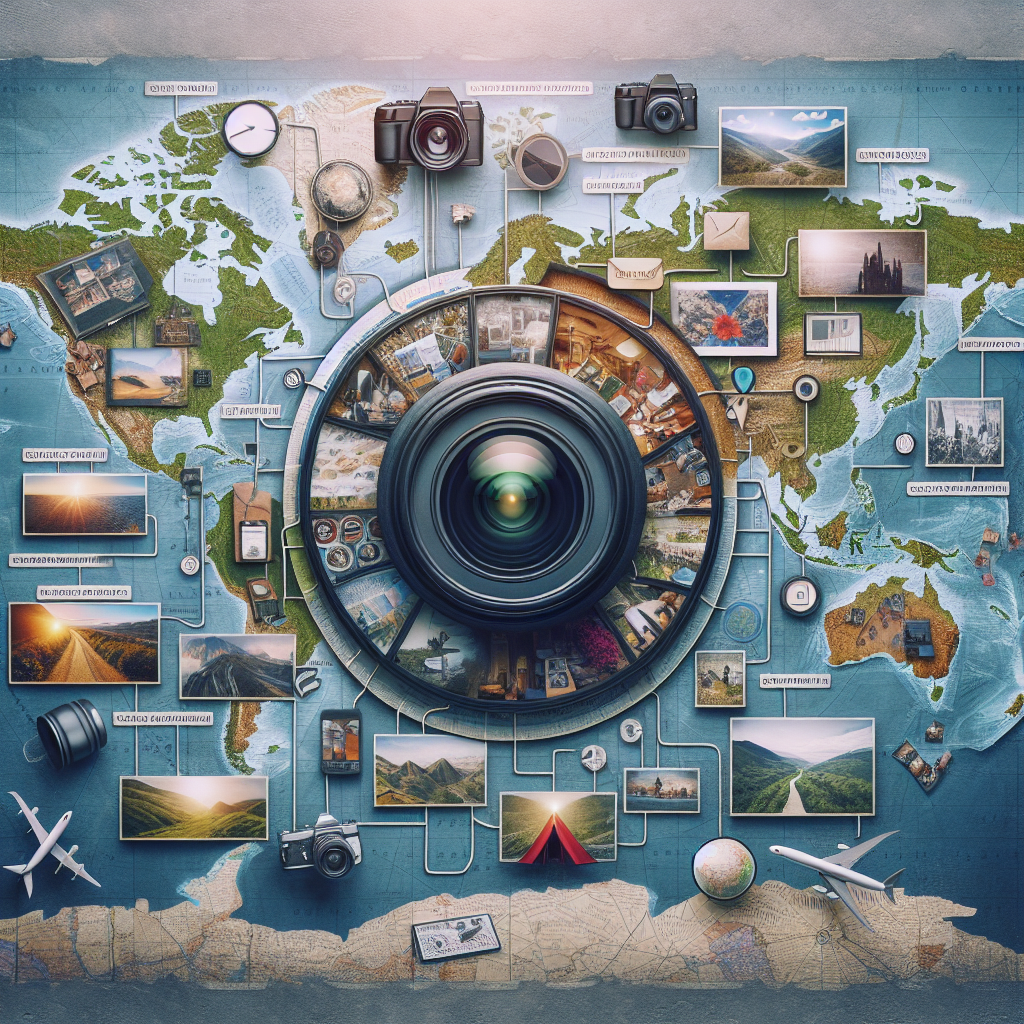If you have a passion for photography and a love for travel, then starting a successful travel photography business might just be the perfect career for you. In this article, you will discover essential tips and strategies on how to turn your passion into a profitable venture. From building a strong portfolio and understanding the market, to effectively marketing your services and managing client relationships, this guide will provide you with everything you need to know to create and manage a thriving travel photography business. So, grab your camera, pack your bags, and get ready to embark on an exciting new adventure in the world of travel photography.

- Choosing the Right Equipment
- Building a Strong Portfolio
- Developing Technical Skills
- Understanding the Travel Photography Market
- Establishing a Brand
- Creating a Business Plan
- Marketing and Promotion
- Effective Client Communication
- Providing Exceptional Customer Service
- Managing Finances and Business Operations
Choosing the Right Equipment
Invest in a high-quality camera
When it comes to travel photography, choosing the right equipment is crucial. Invest in a high-quality camera that will capture stunning images and withstand the rigors of travel. Look for a camera with advanced features such as high resolution, fast autofocus, and a wide ISO range. This will allow you to capture clear and vibrant images in different lighting conditions. Additionally, consider factors such as durability, size, and weight, as you’ll be carrying it around for long periods.
Choose the right lenses
In addition to a high-quality camera, selecting the right lenses is essential for travel photography. Different lenses have different focal lengths and are suitable for various subjects. A wide-angle lens is perfect for capturing landscapes and cityscapes, while a telephoto lens allows you to get close-up shots of wildlife or distant landmarks. Invest in a versatile lens that covers a wide focal range, such as a zoom lens, to ensure you’re prepared for any situation.
Consider purchasing additional accessories
While a camera and lenses are essential, there are other accessories that can enhance your travel photography experience. Consider investing in a sturdy tripod to stabilize your camera, especially for long exposure shots or self-portraits. A remote shutter release is also handy for preventing camera shake and capturing sharp images. Additional accessories such as filters, extra batteries, and memory cards can also come in handy during your travels. Do thorough research and choose accessories that will complement your photography style and requirements.
Building a Strong Portfolio
Shoot a variety of subjects
To build a strong portfolio, it’s important to photograph a variety of subjects. Experiment with different genres such as landscapes, cityscapes, portraits, and architecture. This will not only showcase your versatility as a photographer but also help you find your niche and style. Don’t be afraid to explore off-the-beaten-path locations or include unique perspectives in your compositions. The key is to capture images that tell a story and evoke emotions in viewers.
Showcase your best work
When it comes to creating a portfolio, quality is more important than quantity. Select your best and most compelling images to showcase your skills and attract potential clients. The key is to curate a collection of images that represents your unique style and vision as a travel photographer. Organize your portfolio in a visually appealing manner, either through an online platform or a physical portfolio, and ensure that each image flows seamlessly into the next.
Create an online portfolio
In today’s digital age, having an online portfolio is essential for reaching a wider audience and attracting potential clients. Design a clean and user-friendly website where you can display your portfolio, provide information about your services, and share your travel experiences. Include relevant information such as your contact details and social media links to make it easy for clients to reach out and connect with you. Regularly update your online portfolio with new and captivating images to keep viewers engaged and interested.
Developing Technical Skills
Master exposure and lighting
Understanding exposure and lighting is fundamental to creating captivating travel photographs. Learn how to use your camera’s manual mode to control the exposure triangle – aperture, shutter speed, and ISO – to achieve the desired effect in different lighting situations. Experiment with natural light, as well as artificial lighting techniques such as flash or reflectors, to enhance the mood and atmosphere of your images. Mastering exposure and lighting will allow you to capture well-balanced and visually pleasing photographs.
Learn composition techniques
Composition plays a vital role in travel photography. It involves arranging the elements within a frame to create a visually appealing and impactful image. Learn and practice composition techniques such as the rule of thirds, leading lines, symmetry, and framing to add depth and interest to your photographs. Consider the placement of your subject, the foreground and background elements, and the overall balance of the image. With time and practice, you’ll develop an eye for composition and create visually stunning photographs.
Practice post-processing
Post-processing is an integral part of modern photography. It allows you to enhance and refine your images to bring out their full potential. Familiarize yourself with post-processing software such as Adobe Lightroom or Photoshop and learn basic editing techniques such as adjusting exposure, cropping, and sharpening. However, remember to strike a balance between enhancing your photos and maintaining their authenticity. Develop your own editing style that reflects your vision and storytelling approach.
Understanding the Travel Photography Market
Research target audience
To succeed in the travel photography business, it’s essential to understand your target audience. Research and analyze the demographic and psychographic characteristics of the people who are most likely to be interested in your photography services. Determine their preferences, interests, and motivations when it comes to travel and photography. This deeper understanding will enable you to tailor your marketing strategies, create relevant content, and meet the expectations of your potential clients.
Identify popular destinations and trends
Being aware of popular travel destinations and trends is crucial to stay relevant and attract clients. Keep yourself updated on emerging travel destinations and popular hotspots that are trending among travelers. Research prevailing travel trends such as sustainable tourism, adventure travel, or cultural exploration, and align your photography style and content with these trends. By capturing images that are in demand, you can position yourself as a go-to photographer for these destinations and experiences.
Analyze competition
Competition in the travel photography industry can be fierce, but understanding your competitors can give you a competitive edge. Conduct a thorough analysis of other travel photographers in your niche and study their portfolios, online presence, pricing models, and unique selling propositions. Identify what sets you apart from your competitors and emphasize those strengths in your marketing and branding efforts. Collaboration with other photographers can also be beneficial, as it allows you to learn from each other and expand your network.

Establishing a Brand
Choose a memorable business name
Your business name is central to establishing your brand identity. Choose a memorable and catchy name that reflects your style, values, and services. Consider including keywords that resonate with travel photography, such as “wanderlust,” “adventure,” or “explorer.” Ensure that the chosen name is not already in use by another photography business and that it aligns with your long-term goals and aspirations.
Create a unique logo and website design
Visual branding elements such as a logo and website design contribute to your overall brand image. Create a unique and visually appealing logo that represents your brand and can be easily recognizable. The logo should be versatile enough to be used on various marketing materials, including your website, social media profiles, and promotional materials. Additionally, design a cohesive and well-organized website that reflects your style and provides a seamless user experience for potential clients.
Develop a consistent visual style
Consistency is key when it comes to branding in travel photography. Develop a consistent visual style that is evident in your photographs, editing techniques, and overall presentation. Determine the color palette, tone, and mood that align with your brand and consistently apply them to your images and marketing materials. This will help create a recognizable and cohesive brand identity, making it easier for clients to identify and connect with your work.
Creating a Business Plan
Define your services and target market
A well-defined business plan is crucial to the success of your travel photography business. Start by clearly defining the services you offer, whether it’s destination photography, travel photojournalism, or tourism campaigns. Identify your target market based on the research you conducted earlier, and outline how your services cater to their specific needs and desires. This will serve as a roadmap for your business and help you align your efforts to attract the right clients.
Set pricing and payment policies
Determining your pricing structure is an important aspect of running a successful travel photography business. Research industry standards and factor in your level of expertise, travel expenses, and time commitment when deciding on your rates. Consider offering different packages or pricing tiers to cater to different client budgets and requirements. Clearly communicate your payment policies, including any deposits or upfront fees, and establish a system for invoicing and accepting payments.
Identify marketing strategies
Effective marketing is essential to attract clients and generate business for your travel photography venture. Identify marketing strategies that align with your target audience and budget. This can include a combination of online efforts such as social media marketing, search engine optimization, and content creation, as well as offline strategies like attending travel expos or partnering with local businesses. Develop a marketing calendar to ensure consistent promotion and track the success of your marketing efforts.

Marketing and Promotion
Build a strong online presence
In today’s digital world, having a strong online presence is crucial for any travel photographer. Create profiles on popular social media platforms such as Instagram, Facebook, and Pinterest to showcase your work and engage with potential clients. Regularly update your social media accounts with high-quality images and engaging captions that tell the story behind the photo. Engage with your followers, respond to comments, and collaborate with other travel influencers or brands to increase your reach and visibility.
Utilize social media platforms
Harness the power of social media to promote your travel photography business. In addition to posting high-quality images, leverage the various features and tools offered by social media platforms to reach a wider audience. Utilize hashtags strategically to increase discoverability, participate in photography challenges or contests, and share behind-the-scenes content to give your audience a glimpse into your travel adventures. Engage with your followers by responding to comments, answering questions, and building relationships with potential clients.
Network with other professionals and potential clients
Networking is vital in the travel photography industry, as it can lead to collaborations, referrals, and exposure to new opportunities. Attend industry conferences, workshops, or meetups to connect with like-minded professionals and potential clients. Join online communities or forums where travel photographers gather to share knowledge and experiences. Reach out to brands, tourism boards, or publications that align with your style and interests and explore potential collaboration opportunities. Building strong relationships with others in the industry can help expand your reach and lead to new business opportunities.
Effective Client Communication
Respond promptly to inquiries
Promptly responding to client inquiries is essential for building trust and securing bookings. Aim to reply to inquiries within 24-48 hours or sooner if possible. Establish a system to organize and track incoming inquiries to ensure that no messages are overlooked. Make it a priority to provide clear and concise information, answer any questions the client may have, and offer additional details about your services. By displaying professionalism and attentiveness in your communication, you increase the chances of converting inquiries into bookings.
Ask the right questions to understand client needs
To deliver exceptional service and meet client expectations, it’s essential to ask the right questions to understand their needs and vision. Inquire about their travel plans, preferred shooting locations, desired style, and any specific moments they want to capture. Collecting this information will enable you to tailor your services to their unique requirements and ensure that you deliver a personalized and satisfactory experience. Actively listening to your clients and asking clarifying questions will foster a collaborative relationship and enable you to exceed their expectations.
Maintain clear and professional communication
Throughout the entire client journey, maintain clear and professional communication. Regularly update your clients on the progress of their project, provide them with any necessary information or instructions, and address any concerns or queries they may have. Ensure that your communication is concise, respectful, and reflective of your brand values. By fostering a positive and transparent communication channel, you establish trust and loyalty with your clients, which can lead to repeat business and referrals.

Providing Exceptional Customer Service
Go the extra mile for your clients
Providing exceptional customer service goes beyond capturing great photographs. Strive to exceed your clients’ expectations by going the extra mile. Offer personalized recommendations for their travel destination, help with logistics or local contacts, or provide tips and tricks to enhance their overall travel experience. Keep in touch with your clients even after the project is completed, and surprise them with occasional updates or exclusive offers. By prioritizing customer satisfaction and building lasting relationships, you create a positive reputation that will help grow your business.
Deliver high-quality images in a timely manner
Delivering high-quality images to your clients in a timely manner is crucial. Set realistic turnaround times and communicate them clearly to your clients. Use efficient file-sharing platforms or online galleries to deliver your images securely and conveniently. Ensure that your editing process maintains the consistent visual style that you’ve established, while also keeping in mind any specific requests or preferences of your clients. By delivering your work promptly and maintaining high standards of quality, you demonstrate professionalism and create a positive client experience.
Request and respond to client feedback
Feedback is invaluable for your growth as a travel photographer and the improvement of your services. Actively seek feedback from your clients upon project completion and encourage them to share their thoughts and suggestions. Embrace constructive criticism and use it as an opportunity to enhance your skills and address any areas of improvement. Respond to feedback promptly and professionally, showing your clients that their opinions are valued. By actively engaging with feedback, you build trust with your clients and continuously enhance your services to meet their evolving needs.
Managing Finances and Business Operations
Track income and expenses
Managing your finances is essential for the sustainability and success of your travel photography business. Develop a system to track your income and expenses accurately. Keep all receipts and invoices organized and consider using accounting software or hiring an accountant to assist you. Regularly review your financial records to analyze your profitability, identify areas of unnecessary spending, and make informed decisions for your business. By maintaining a clear financial overview, you can optimize your revenue and ensure the long-term viability of your enterprise.
Handle contracts and legal issues
Protecting your business legally is crucial in the photography industry. Develop clear and comprehensive contracts that outline the scope of work, usage rights, payment terms, and other important details. Ensure that both parties involved fully understand and agree to the terms outlined in the contract before proceeding with any work. Familiarize yourself with copyright laws, model releases, and other legal considerations relevant to travel photography. Consult with a lawyer or legal professional to ensure that your business operations comply with local laws and regulations.
Stay organized with scheduling and bookings
Efficiently managing your schedule and bookings is key to running a successful travel photography business. Use a digital calendar or project management tool to track your appointments, shoots, and deadlines. Communicate clearly with your clients regarding availability, shoot dates, and any necessary travel arrangements. Develop a system to manage bookings, such as a client database or booking software, to streamline your workflow and avoid double bookings or scheduling conflicts. Staying organized will enable you to deliver your services smoothly and provide peace of mind to your clients.







